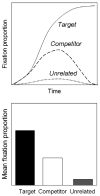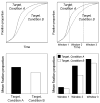Statistical and computational models of the visual world paradigm: Growth curves and individual differences
- PMID: 19060958
- PMCID: PMC2593828
- DOI: 10.1016/j.jml.2007.11.006
Statistical and computational models of the visual world paradigm: Growth curves and individual differences
Abstract
Time course estimates from eye tracking during spoken language processing (the "visual world paradigm", or VWP) have enabled progress on debates regarding fine-grained details of activation and competition over time. There are, however, three gaps in current analyses of VWP data: consideration of time in a statistically rigorous manner, quantification of individual differences, and distinguishing linguistic effects from non-linguistic effects. To address these gaps, we have developed an approach combining statistical and computational modeling. The statistical approach (growth curve analysis, a technique explicitly designed to assess change over time at group and individual levels) provides a rigorous means of analyzing time course data. We introduce the method and its application to VWP data. We also demonstrate the potential for assessing whether differences in group or individual data are best explained by linguistic processing or decisional aspects of VWP tasks through comparison of growth curve analyses and computational modeling, and discuss the potential benefits for studying typical and atypical language processing.
Figures










References
-
- Allopenna PD, Magnuson JS, Tanenhaus MK. Tracking the time course of spoken word recognition using eye movements: Evidence for continuous mapping models. Journal of Memory and Language. 1998;38:419–439.
-
- Altmann GTM, Kamide Y. Incremental interpretation at verbs: Restricting the domain of subsequent reference. Cognition. 1999;73:247. - PubMed
-
- Chambers CG, Tanenhaus MK, Magnuson JS. Actions and affordances in syntactic ambiguity resolution. Journal of Experimental Psychology: Learning, Memory, and Cognition. 2004;30:687–696. - PubMed
-
- Cooper RM. The control of eye fixation by the meaning of spoken language: A new methodology for the real-time investigation of speech perception, memory, and language processing. Cognitive Psychology. 1974;6:84–107.
-
- Dahan D, Magnuson JS, Tanenhaus MK. Time course of frequency effects in spoken-word recognition: Evidence from eye movements. Cognitive Psychology. 2001a;42:317–367. - PubMed
Grants and funding
LinkOut - more resources
Full Text Sources
